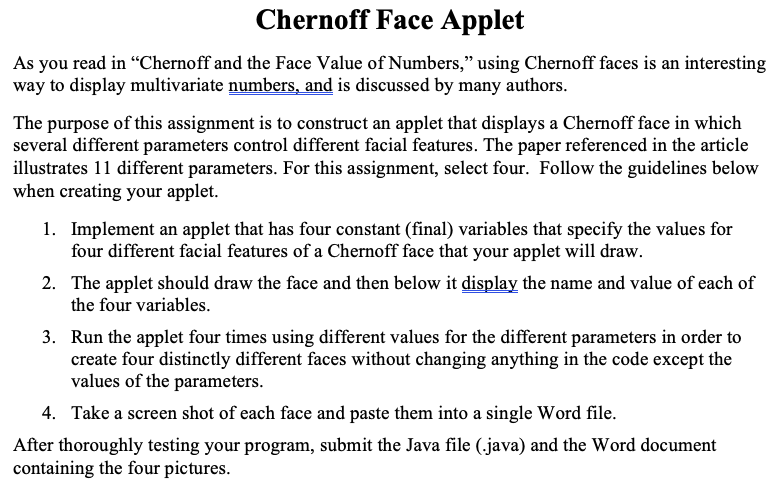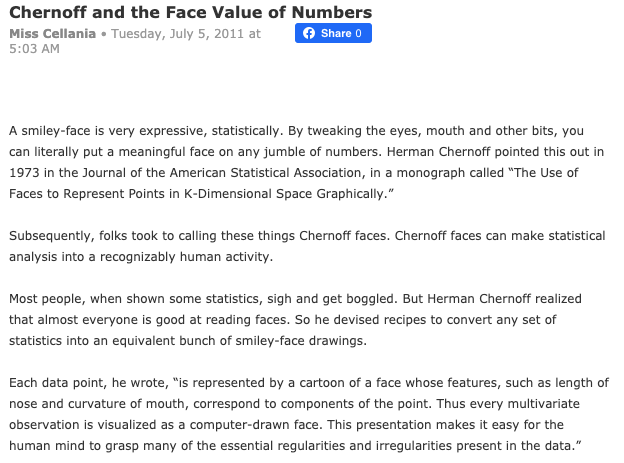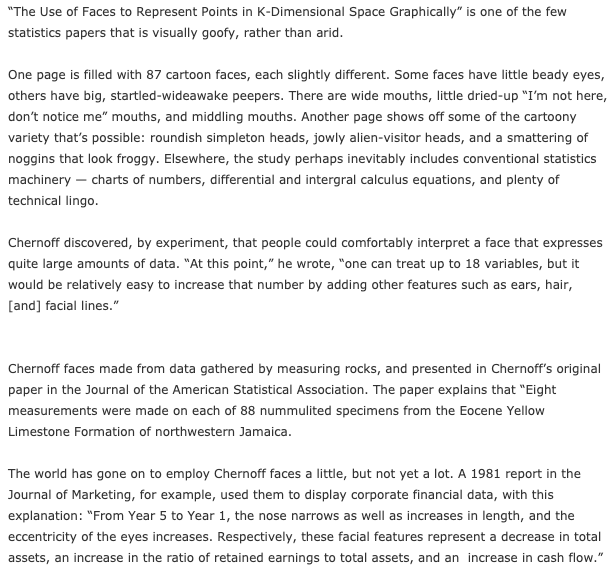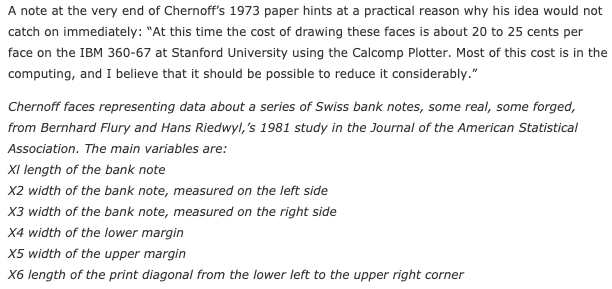




The purpose of this assignment is to construct an applet that displays a Chernoff face in which several different parameters control different facial features. The paper referenced in the article illustrates 11 different parameters. For this assignment, select four. Follow the guidelines below when creating your applet. 1. Implement an applet that has four constant (final) variables that specify the values for four different facial features of a Chernoff face that your applet will draw. 2. The applet should draw the face and then below it display the name and value of each of the four variables. 3. Run the applet four times using different values for the different parameters in order to create four distinctly different faces without changing anything in the code except the values of the parameters. 4. Take a screenshot of each face and paste them into a single Word file. After thoroughly testing your program, submit the Java file (.java) and the Word document containing the four pictures. Chernoff Face Applet As you read in "Chernoff and the Face Value of Numbers, using Chernoff faces is an interesting way to display multivariate numbers, and is discussed by many authors. The purpose of this assignment is to construct an applet that displays a Chernoff face in which several different parameters control different facial features. The paper referenced in the article illustrates 11 different parameters. For this assignment, select four. Follow the guidelines below when creating your applet. 1. Implement an applet that has four constant (final) variables that specify the values for four different facial features of a Chernoff face that your applet will draw. 2. The applet should draw the face and then below it display the name and value of each of the four variables. 3. Run the applet four times using different values for the different parameters in order to create four distinctly different faces without changing anything in the code except the values of the parameters. 4. Take a screen shot of each face and paste them into a single Word file. After thoroughly testing your program, submit the Java file (.java) and the Word document containing the four pictures. Chernoff and the Face Value of Numbers Miss Cellania Tuesday, July 5, 2011 at Share o 5:03 AM A smiley-face is very expressive, statistically. By tweaking the eyes, mouth and other bits, you can literally put a meaningful face on any jumble of numbers. Herman Chernoff pointed this out in 1973 in the Journal of the American Statistical Association, in a monograph called "The Use of Faces to Represent points in K-Dimensional Space Graphically." Subsequently, folks took to calling these things Chernoff faces. Chernoff faces can make statistical analysis into a recognizably human activity. Most people, when shown some statistics, sigh and get boggled. But Herman Chernoff realized that almost everyone is good at reading faces. So he devised recipes to convert any set of statistics into an equivalent bunch of smiley-face drawings. Each data point, he wrote, "is represented by a cartoon of a face whose features, such as length of nose and curvature of mouth, correspond to components of the point. Thus every multivariate observation is visualized as a computer-drawn face. This presentation makes it easy for the human mind to grasp many of the essential regularities and irregularities present in the data." "The Use of Faces to Represent Points in K-Dimensional Space Graphically" is one of the few statistics papers that is visually goofy, rather than arid. One page is filled with 87 cartoon faces, each slightly different. Some faces have little beady eyes, others have big, startled-wideawake peepers. There are wide mouths, little dried-up "I'm not here, don't notice me" mouths, and middling mouths. Another page shows off some of the cartoony variety that's possible: roundish simpleton heads, jowly alien-visitor heads, and a smattering of noggins that look froggy. Elsewhere, the study perhaps inevitably includes conventional statistics machinery - charts of numbers, differential and intergral calculus equations, and plenty of technical lingo. Chernoff discovered, by experiment, that people could comfortably interpret a face that expresses quite large amounts of data. "At this point," he wrote, "one can treat up to 18 variables, but it would be relatively easy to increase that number by adding other features such as ears, hair, [and] facial lines." Chernoff faces made from data gathered by measuring rocks, and presented in Chernoff's original paper in the Journal of the American Statistical Association. The paper explains that "Eight measurements were made on each of 88 nummulited specimens from the Eocene Yellow Limestone Formation of northwestern Jamaica. The world has gone on to employ Chernoff faces a little, but not yet a lot. A 1981 report in the Journal of Marketing, for example, used them to display corporate financial data, with this explanation: "From Year 5 to Year 1, the nose narrows as well as increases in length, and the eccentricity of the eyes increases. Respectively, these facial features represent a decrease in total assets, an increase in the ratio of retained earnings to total assets, and an increase in cash flow." A note at the very end of Chernoff's 1973 paper hints at a practical reason why his idea would not catch on immediately: "At this time the cost of drawing these faces is about 20 to 25 cents per face on the IBM 360-67 at Stanford University using the Calcomp Plotter. Most of this cost is in the computing, and I believe that it should be possible to reduce it considerably." Chernoff faces representing data about a series of Swiss bank notes, some real, some forged, from Bernhard Flury and Hans Riedwyl,'s 1981 study in the Journal of the American Statistical Association. The main variables are: Xl length of the bank note X2 width of the bank note, measured on the left side X3 width of the bank note, measured on the right side X4 width of the lower margin X5 width of the upper margin X6 length of the print diagonal from the lower left to the upper right corner The purpose of this assignment is to construct an applet that displays a Chernoff face in which several different parameters control different facial features. The paper referenced in the article illustrates 11 different parameters. For this assignment, select four. Follow the guidelines below when creating your applet. 1. Implement an applet that has four constant (final) variables that specify the values for four different facial features of a Chernoff face that your applet will draw. 2. The applet should draw the face and then below it display the name and value of each of the four variables. 3. Run the applet four times using different values for the different parameters in order to create four distinctly different faces without changing anything in the code except the values of the parameters. 4. Take a screenshot of each face and paste them into a single Word file. After thoroughly testing your program, submit the Java file (.java) and the Word document containing the four pictures. Chernoff Face Applet As you read in "Chernoff and the Face Value of Numbers, using Chernoff faces is an interesting way to display multivariate numbers, and is discussed by many authors. The purpose of this assignment is to construct an applet that displays a Chernoff face in which several different parameters control different facial features. The paper referenced in the article illustrates 11 different parameters. For this assignment, select four. Follow the guidelines below when creating your applet. 1. Implement an applet that has four constant (final) variables that specify the values for four different facial features of a Chernoff face that your applet will draw. 2. The applet should draw the face and then below it display the name and value of each of the four variables. 3. Run the applet four times using different values for the different parameters in order to create four distinctly different faces without changing anything in the code except the values of the parameters. 4. Take a screen shot of each face and paste them into a single Word file. After thoroughly testing your program, submit the Java file (.java) and the Word document containing the four pictures. Chernoff and the Face Value of Numbers Miss Cellania Tuesday, July 5, 2011 at Share o 5:03 AM A smiley-face is very expressive, statistically. By tweaking the eyes, mouth and other bits, you can literally put a meaningful face on any jumble of numbers. Herman Chernoff pointed this out in 1973 in the Journal of the American Statistical Association, in a monograph called "The Use of Faces to Represent points in K-Dimensional Space Graphically." Subsequently, folks took to calling these things Chernoff faces. Chernoff faces can make statistical analysis into a recognizably human activity. Most people, when shown some statistics, sigh and get boggled. But Herman Chernoff realized that almost everyone is good at reading faces. So he devised recipes to convert any set of statistics into an equivalent bunch of smiley-face drawings. Each data point, he wrote, "is represented by a cartoon of a face whose features, such as length of nose and curvature of mouth, correspond to components of the point. Thus every multivariate observation is visualized as a computer-drawn face. This presentation makes it easy for the human mind to grasp many of the essential regularities and irregularities present in the data." "The Use of Faces to Represent Points in K-Dimensional Space Graphically" is one of the few statistics papers that is visually goofy, rather than arid. One page is filled with 87 cartoon faces, each slightly different. Some faces have little beady eyes, others have big, startled-wideawake peepers. There are wide mouths, little dried-up "I'm not here, don't notice me" mouths, and middling mouths. Another page shows off some of the cartoony variety that's possible: roundish simpleton heads, jowly alien-visitor heads, and a smattering of noggins that look froggy. Elsewhere, the study perhaps inevitably includes conventional statistics machinery - charts of numbers, differential and intergral calculus equations, and plenty of technical lingo. Chernoff discovered, by experiment, that people could comfortably interpret a face that expresses quite large amounts of data. "At this point," he wrote, "one can treat up to 18 variables, but it would be relatively easy to increase that number by adding other features such as ears, hair, [and] facial lines." Chernoff faces made from data gathered by measuring rocks, and presented in Chernoff's original paper in the Journal of the American Statistical Association. The paper explains that "Eight measurements were made on each of 88 nummulited specimens from the Eocene Yellow Limestone Formation of northwestern Jamaica. The world has gone on to employ Chernoff faces a little, but not yet a lot. A 1981 report in the Journal of Marketing, for example, used them to display corporate financial data, with this explanation: "From Year 5 to Year 1, the nose narrows as well as increases in length, and the eccentricity of the eyes increases. Respectively, these facial features represent a decrease in total assets, an increase in the ratio of retained earnings to total assets, and an increase in cash flow." A note at the very end of Chernoff's 1973 paper hints at a practical reason why his idea would not catch on immediately: "At this time the cost of drawing these faces is about 20 to 25 cents per face on the IBM 360-67 at Stanford University using the Calcomp Plotter. Most of this cost is in the computing, and I believe that it should be possible to reduce it considerably." Chernoff faces representing data about a series of Swiss bank notes, some real, some forged, from Bernhard Flury and Hans Riedwyl,'s 1981 study in the Journal of the American Statistical Association. The main variables are: Xl length of the bank note X2 width of the bank note, measured on the left side X3 width of the bank note, measured on the right side X4 width of the lower margin X5 width of the upper margin X6 length of the print diagonal from the lower left to the upper right corner











